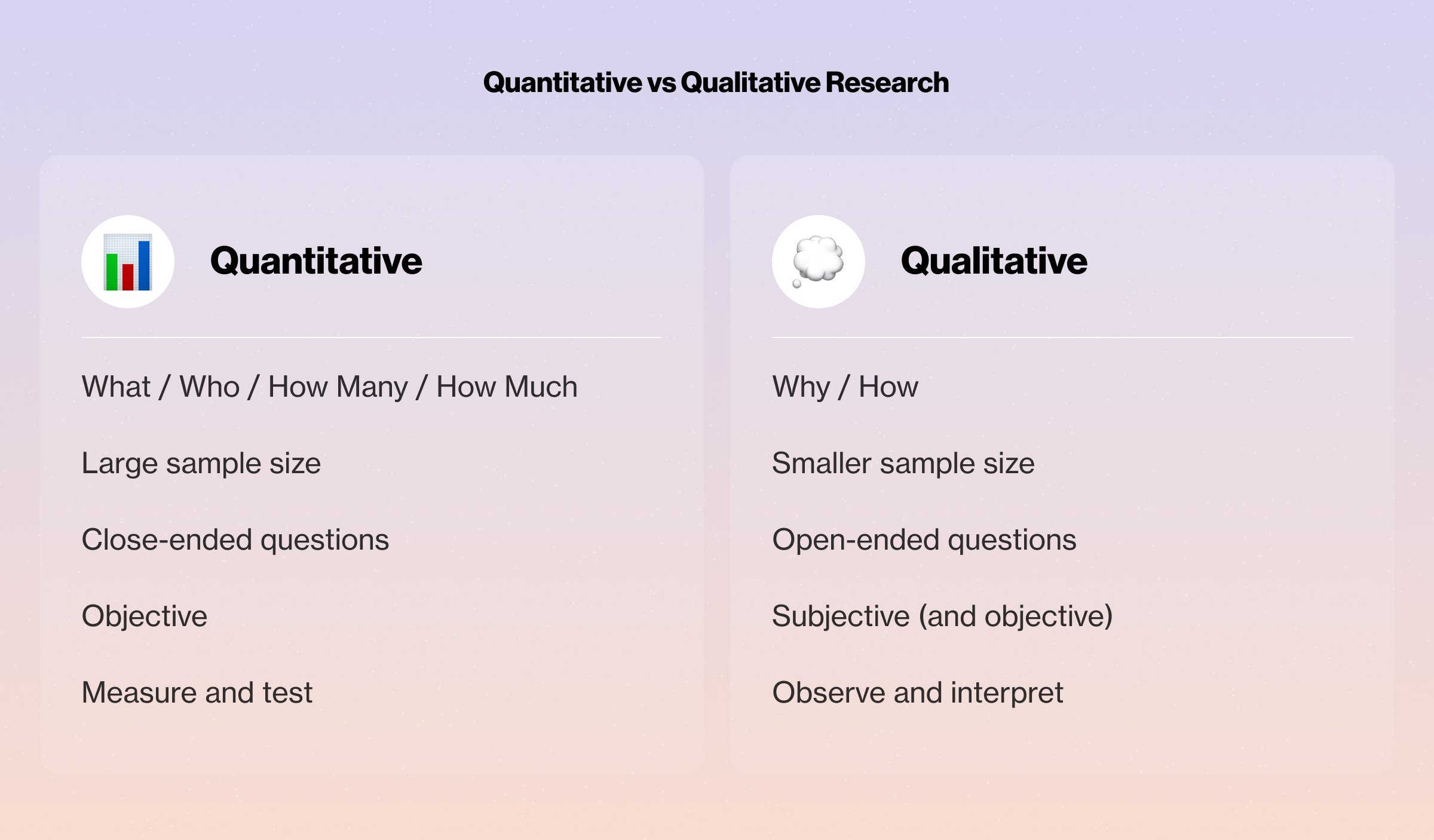
By Megan Doll
Creating user-centered products is the holy grail of product development. But how do you ensure that what you’re building truly meets your users’ needs and expectations? The answer lies in product research, and specifically, qualitative research.
Qualitative UX research is essential to building truly user-centered products. It brings the human perspective to the forefront — challenging assumptions, uncovering unmet needs, and aligning business goals with what actually matters to users. Far from being slow or cumbersome, qualitative research methods deliver rich, actionable insights — fast — and at any stage of the product life cycle.
This article dives into what qualitative research is, why it’s indispensable for creating effective products that drive revenue, and how you can integrate it effectively into your design and development processes.
What Is Qualitative Research?
Qualitative research tells the intimate, human-scaled stories of products and services. To accomplish this, researchers engage participants directly to understand their subjective experiences and to observe their unspoken behaviors. The output is descriptive data and insights that illuminate the path forward, enabling teams to design with empathy and conviction.
Qualitative vs. Quantitative Research: How to Spot the Differences
At its core, qualitative insights explain the “why” and “how” behind user behavior. It goes beyond numbers to unearth the desires, experiences, and motivations that shape how people interact with your product.
In contrast, quantitative research uses numerical data to measure and analyze user behaviors and attitudes in aggregate. It helps identify patterns, track trends, and seed hypotheses across larger populations.
Qualitative research is essential for understanding the root cause of a phenomenon, whereas quantitative research makes visible the effect.
Here’s a quick comparison to clarify the distinction between qualitative and quantitative research:

While these distinctions are useful, it’s not always so cut-and-dry. Like the yin-yang symbol, each modality can contain a drop of its counterpart. For example, quantitative surveys often include open-ended questions for sentiment analysis; while qualitative studies may include Likert-scale questions to better ground and compare subjective feedback. Other methods — such as benchmarking or card sorting — might straddle qualitative and quantitative distinctions.
No single method or modality captures the full complexity of human behavior. Qualitative research is an essential component of holistic product development, but it’s not the only option. Using quantitative and qualitative methods in tandem via a mixed-methods approach is the most effective, as each complements the other — bridging gaps and uncovering blind spots.
Our perspective
When faced with important decisions, it’s common to fall under the spell of quantification bias — a tendency to favor numerical information because it appears more empirical and trustworthy. If stakeholders over-index on metrics and dashboards, they risk missing the bigger picture of why users feel and behave the way they do.
Why Qualitative Research Is Essential (And a Little About When)
Qualitative research isn’t a detour on the product roadmap — it’s an upgrade to the road itself. Far from slowing down the process, it smooths the path forward by uncovering insights that prevent costly wrong turns and aggravating potholes.
Here are four reasons why conducting a qualitative study is a must for building user-centered products:
1. Challenges Assumptions and Uncovers Blind Spots
Qualitative user research brings fresh perspectives to the table, and provides an important external counterpoint to a business’ own internal logic, assumptions, and objectives. For example, an in-depth interview with a user might reveal buyer motivations you hadn’t considered or unmet needs that require a second look.
2. Prevents Costly Mistakes
Skipping qualitative research can lead to “potholes” in your product roadmap. These potholes may come in the form of designing solutions for non-problems, failing to innovate, or overlooking usability blockers and pain points. Uncovering major issues early can save both time and money by preventing a need for significant redesigns later on.
3. Holds the Potential for Nimbleness and Flexibility
Qualitative UXR is the one of the most adaptable forms of research: it can be conducted in a variety of scenarios and settings, from an office hallway to a lab setting and beyond. Methods can be scaled to fit timelines, however, there are trade-offs between immediacy and comprehensiveness to consider when rightsizing research.
Our perspective
At any stage of the product development process, qualitative research can offer an important gut-check. Think of these studies as signposts along the way, keeping you on track to customer satisfaction.

Common Challenges of Qualitative Research
Good qualitative research cannot be automated or preprogrammed, but every method — qualitative or quantitative — has its limitations.
Three challenges to conducting qualitative research include:
1. Setup Can Be an Uphill Climb
While qualitative research boasts a high insight yield — given its small sample size — the quality of that yield hinges on the skill and sweat of its cultivators. High-impact qualitative research requires experienced practitioners to articulate the research objectives, determine the methods, craft the protocol, recruit participants, conduct sessions, observe participant behaviors, and analyze the data.
At Blink, our research teams are carefully assembled with dedicated researchers, directors, project managers, lab technicians, and recruiters to ensure the highest standards of data collection.
2. A Limited Window into the Whole Picture
While qualitative research is holistic, it is not absolute. Its strength lies in providing rich, descriptive detail and articulating user experiences and motivations — insights that can stand on their own. However, no single study can capture the full story of a product.
Due to its small sample size, qualitative research is most impactful when its findings are triangulated with other methods and inputs. UX research doesn’t exist in a vacuum; it gains depth and dimension through dialogue with analytics, market research, customer support, and other teams that track user behaviors and feedback.
3. Turning Stories into a Strategic Route
Qualitative research often brings to light nuanced, contextual insights that don’t always easily translate into straightforward design decisions. One of the greatest challenges of qualitative research is coupling descriptive insights with prescriptive recommendations.
At Blink, we focus on storytelling for impact: insights that drive alignment and recommendations that spur action.

How to Use Qualitative Research Throughout Product Research and Development
Qualitative research can provide high-impact value to product research at any stage of the product development cycle, from the kernel of an idea to a launched product with an established user base.
Types of Qualitative Research Methods
1. Foundational Research
Foundational, discovery, or exploratory research helps you understand the problem space and identify opportunities. Methods include:
- In-Depth Interviews (IDIs): One-on-one interviews focus on understanding an aspect of the target audience’s life or experience in detail. It lays the groundwork for empathizing with users and identifying new opportunities. This method can be coupled with other activities (e.g., card sorting, concept mapping) or stimuli (e.g., personal artifacts) to better understand the problem space.
- Mental Models and Thinking Styles: Mental modeling uses affinity mapping to group and conceptualize tasks by a user’s intention or motivation. Distinct from archetypes and personas — which generally ascribe fixed motives to a user-type — mental models and thinking styles are context-aware, acknowledging that a single user may have different motivations at different times.
- Archetypes and Personas: These are representations of your target user, including their goals, motivations, behavioral patterns, and expectations of using a product or service.
2. Building, Evaluating, and Iterating
Qualitative research can also guide prototype development, feature refinement, and user feedback collection:
- Concept Testing: An early-stage method to test ideas and approaches with real users. Concept testing can be conducted with designs at various stages of fidelity to get signal on everything from overall preferences to detailed feedback on specific concepts or features.
- Co-Design: Mini-workshops run with individual participants to uncover details and visualize workflows or solutions. Participants co-create tangible design artifacts while articulating their abstract thought process and answering questions.
- Diary Studies: These studies collect longitudinal data about activities, behaviors, and experiences over time through ongoing participant journaling. Diary entries are often multimedia, enabling participants to provide rich, in-the-moment contextual data.
- Jobs to be Done: An evaluation method that examines core tasks, touchpoints, experiences across a user journey. JTBD frameworks make visible user workflows and highlights opportunities for improvement.
- Customer Success Outcomes (CSOs): Similar to JTBD, a CX measurement framework like CSOs articulates core product jobs alongside how the customer measures success. The jobs are mapped to the customer journey and paired with metrics to provide a dynamic and holistic view of the customer experience.
- Usability Testing: A form of testing used to assess how easily users can complete key tasks using an interface, whether isolated or end-to-end. Usability testing combines participant feedback with researcher observation to flag pain points and comprehension gaps.
- Out-of-the-Box Experience (OOBE): A subset of hardware research, OOBE testing assesses the experience of unboxing and setting up a new device. These studies examine everything from packaging materials and hardware design to instructional materials and onboarding.
The Human Advantage of Qualitative Research
Qualitative research isn’t a detour in product development; it’s the GPS guiding your team toward the destination of user-centered innovation.
Far from being a “nice-to-have,” qualitative research is an essential tool that uncovers the human perspective, challenges assumptions, and drives meaningful innovation.
At its heart, qualitative research doesn’t just aim to improve products; it’s about improving the lives of those who use them. By anchoring your decisions to real human experiences, you foster trust, loyalty, and relevance for your brand.
